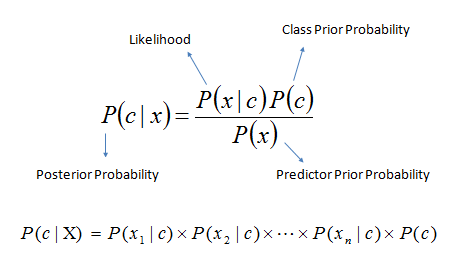This article was published as a part of the Data Science Blogathon.
Introduction
During the pandemic, a significant increase in the number of followers on “Twitter” was noticed as compared to months before it. This clearly shows how “Twitter” has gained its importance and trust across the globe. Many pieces of research imply that citizens are interested in being informed about emergencies through social network platforms like Twitter, and government officials should also use them.
While working on a classification problem (Natural Language Processing) in which tweets (along with other features) were to be predicted, as to whether they were tweeted during the COVID-19 pandemic or not. Even after using the “Naive Bayes algorithm” as my suitable model, during testing, the predictions were somewhat suspicious. “The cause of such a problem was a zero probability problem for the test data”. The most reliable solution to this problem is to use a smoothing technique, more particularly Laplace Smoothing.
This article is built upon the assumption that you have a basic understanding of Naïve Bayes.

Table of contents
What was so suspicious about the results?
Example-1,
Consider an Amazon Inc. dataset, in which given reviews (text) has to be classified to be either positive or negative. This type of real-life problem holds a lot of significance in deciding the future strategy for a giant multinational like Amazon.
With the help of the present training set, we build a likelihood table. However, when likelihood values are used for predicting the test dataset some words occur only in the test dataset but not in the training set.
For example, a test query has form,
Query review= x1x2x’
Let, a test sample have three words, where we assume x1 and x2 are present in the training data but not x’. So we have the likelihood for these two words. To predict whether the review is positive or negative, we compare P(positive/review) and P(negative/review) and choose the maximum probability out of the two to our prediction for review.
We use the Bayes theorem to calculate these probabilities. While calculating these probabilities, we don’t involve the evidence for our calculations since evidence remains constant for all the classes. So, now probability equation becomes,
P(positive/review) = K*P(x1/positive)*P(x2/positive)*P(x’/positive)*P(positive)
Similarly,
P(negative/review) = K*P(x1/negative)*P(x2/negative)*P(x’/negative)*P(negative)
Here k is the proportionality constant.
In the likelihood table, the value of P(x1/positive), P(x2/positive) and P(positive) are present but P(x’/positive) is not present since x’ is not present in our training data. As we have no value for this probability. Now, we are unable to be sure about the prediction and our model performed poorly. So, the question is what should we do?
Idea-1: Ignore the term P(x’/positive)
Ignoring the terms P(x’/positive) is analogous to replacing its probability value to 1 which implies we have the same probability of P(x’/positive) and P(x’/negative). As x’ is now present when we are calculating probabilities, we are eventually able to make a decision. However, this approach seems logically incorrect.
Idea-2: In a bag of words model, we count the occurrence of words. If occurrences of word x’ in training are 0. According to that
P(x’|positive)=0 and P(x’|negative)=0, but this will make both P(positive|review) and P(negative|review) equal to 0. This is the problem of zero probability. So, how to deal with this problem?
Let’s see one more example.
Example-2,
Say there are two classes P and Q with features or attributes X, Y, and Z, as follows:
P: X=5, Y=2, Z=0
(In the class P, X appears 5 times and Y appears 2 times)
Q: X=0, Y=3, Z=4
(In the class Q, Z appears 4 times and Y appears 3 times)
Let’s see what happens when you throw away features that appear zero times.
Idea-1: Throw Away Features that Appear Zero Times In Any Class
If you throw away features X and Z because they appear zero times in any of the classes, then you are only left with feature Y to classify documents with.
And losing that information is a bad thing as described below!
If you’re presented with a test document as follows:
Y=1, Z=3
(It contains Y once and Z three times)
Now, since you’ve discarded the features X and Y, you won’t be able to tell whether the above document belongs to class P or class Q.
So, losing any feature information is a bad thing!
Idea-2: Throw Away Features That Appear Zero Times In All Classes
Is it possible to get around this problem by discarding only those features that appear zero times in all of the classes?
No, because that would create its own specific difficulties!
The following test document illustrates what would happen if we did that:
X=3, Y=1, Z=1
The probability of P and Q would both become zero (because we did not throw away the zero probability of X in class Q and the zero probability of Z in class P).
Idea-3: Don’t Throw Anything Away – Use Smoothing Instead
Smoothing allows you to classify both the above documents correctly because:
- You do not lose count of information in classes where such information is available.
- You do not have to contend with zero counts.
From both of these examples, you will see that smoothing is the best technique to solve the problem of zero probability error.
We now introduce Laplace smoothing, a technique for smoothing categorical data.
1. A small-sample correction, or pseudo-count, will be incorporated in every probability estimate.
2. Consequently, no probability will be zero.
3. This is a way of regularizing Naive Bayes, and when the pseudo-count is zero, it is called Laplace smoothing.
4. While in the general case it is often called Lidstone smoothing.
Note: In statistics, additive smoothing, also called Laplace smoothing or Lidstone smoothing, is a technique used to smooth categorical data.
Laplace smoothing
It is introduced to solve the problem of zero probability i.e. when a query point contains a new observation, which is not yet seen in training data while calculating probabilities.
The idea behind Laplace Smoothing: To ensure that our posterior probabilities are never zero, we add 1 to the numerator, and we add k to the denominator. So, in the case that we don’t have a particular ingredient in our training set, the posterior probability comes out to 1 / N + k instead of zero. Plugging this value into the product doesn’t kill our ability to make a prediction as plugging in a zero does.
Now, we will see the mathematical formulation of Laplace smoothing,
Using Laplace smoothing, we can represent P(x’|positive) as,
P(x’/positive)= (number of reviews with x’ and target_outcome=positive + α) / (N+ α*k)
Here, alpha(α) represents the smoothing parameter,
K represents the dimensions(no of features) in the data,
N represents the number of reviews with target_outcome=positive
If we choose a value of α!=0 (not equal to 0), the probability will no longer be zero even if a word is not present in the training dataset but If we choose α value as zero, then there is no smoothing happens and the problem is not solved yet.
What happens if we change the value of alpha?
Let’s say the occurrence of word x is 3 with target_outcome=positive in training data. Assuming we have 4 features in our dataset, i.e., K=4 and N=200 (total number of positive reviews). Then,
P(x’/positive)= 3 + α / 200+4*α
Case 1- when alpha=1
P(x’|positive) = 4/204
Case 2- when alpha = 100
P(x’|positive) = 103/600
Case 3- when alpha=1000
P(x’|positive) = 1003/4200
Case 4- when alpha=5000
P(x’|positive) = 5003/20200
Conclusion: As alpha increases, the likelihood probability drives towards uniform distribution i.e. the probability value will be 0.5 (Using higher alpha values will push the likelihood towards a value of 0.5, i.e., the probability of a word equal to 0.5 for both the positive and negative reviews). Most of the time, alpha = 1 is being used to resolve the problem of zero probability in the Naive Bayes algorithm.
NOTE: Sometimes Laplace smoothing technique is also known as “Add one smoothing”. In Laplace smoothing, 1 (one) is added to all the counts, and thereafter, the probability is calculated. This is one of the most trivial smoothing techniques out of all the techniques.
Precautions while choosing the value of alpha:
‘α’ should not disturb the uniform probabilities that are assigned to unknown data/new observations.
Finding Optimal ‘α’:
Here, alpha is a hyper-parameter and you have to tune it. The basic methods fortune it is as follows:
1. Using elbow plot, try plotting ‘performance metric’ v/s ‘α’ hyper-parameter.
2. In most cases, the best way to determine optimal values of alpha is through a grid search over possible parameter values, using cross-validation to evaluate the performance of the model on your data at each value.
End Notes
In this post, you learned about a smoothing technique used in Natural Language Processing(NLP). It is not the only smoothing technique but in this article, we learned only theoretical concepts and mathematical formulation of Laplace Smoothing. You should try to implement it in real-life projects.
Thanks for reading!
I hope all the things explained in this article are clear to you.
Please don’t forget to share your thoughts on this with me.
If you have any queries, please ask them in the comments below and I will do my best to resolve them.
FAQs
Laplace smoothing is a technique in NLP that prevents zero probability estimates for unseen n-grams, improving the accuracy of language models.
Laplace smoothing prevents zero probability estimates for unseen events, improving the accuracy of machine learning models.
About the Author
Chirag Goyal
Currently, I pursuing my Bachelor of Technology (B.Tech) in Computer Science and Engineering from the Indian Institute of Technology Jodhpur(IITJ). I am very enthusiastic about Machine learning, Deep Learning, and Artificial Intelligence. If you want to connect with me here is the link to my Linkedin profile.
If you are interested to read my other articles also, here is the link.
The media shown in this article are not owned by Analytics Vidhya and is used at the Author’s discretion.




